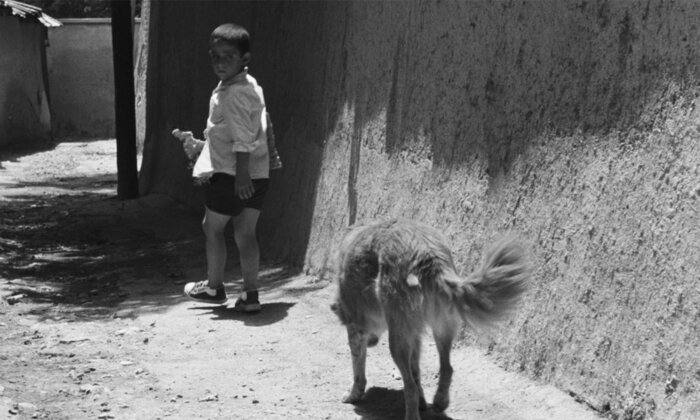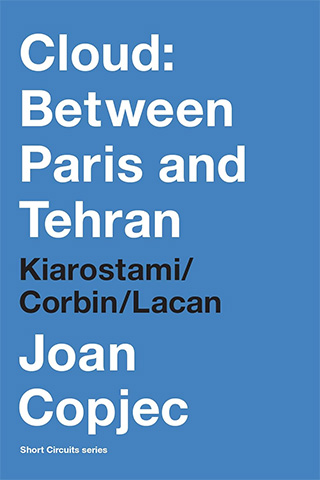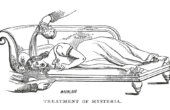Abbas Kiarostami’s Cinema of Subtraction

“Bread and Alley” (1970), Abbas Kiarostami’s first film, was made under the auspices of Kanun (the Center for the Intellectual Development of Children and Young Adults), a cultural organization founded in 1965 by the wife of Mohamad Reza Shah, later deposed by the Iranian Revolution. A short, 10-minute black-and-white film, it features a young boy who must negotiate his way past a menacing-looking dog. The film is devoid of dialogue, its only sound that of the extradiegetic Beatles song, “Ob-La-Di, Ob-La-Da,” which accompanies the boy’s carefree, pre-dog-sighting stride, only to disappear and resume again after the canine threat has been deflected. It is a sweet film, simple and straightforward on its surface.
Yet it bears a heavy burden, not only because Kiarostami referred to it as “the mother of all [his] films.” For others, too, it heralded — or so it has been effectively argued — the Kiarostami aesthetic and paradigm: realistic in the sense that it presents a pristine, uncluttered vision of the world, modestly focused on a minor incident involving a protagonist, solitary and single-minded, who relies solely on his own stubborn will and an ingenuity that allows him to overcome the challenges confronting him.

While it is acknowledged that in later films, the protagonists are not always young, nor are they always male, and often tend to be less irresistibly likable or capable of resolving the problems they confront, these exceptions do nothing to address the larger misconceptions embedded in the above account. There is, I argue in my book, a considerable distance between the intent of “Bread and Alley” and the intent given to it by others less thoughtful about — and sometimes very critical of — what they take to be the basic paradigm of the director’s work.
Critics claim that Kiarostami is a humanist or a realist in the ordinary sense, that he was indifferent to the plight of women, or turned his back on his own culture and countrymen by making films for export to satisfy a touristic gaze. They also argue that he failed to acknowledge, let alone confront, the stifling political circumstances that were choking the country, or take Iran’s leaders and policies to task, as other filmmakers did. That these criticisms are unfounded can only be refuted through rigorous readings of the films themselves.
There is a considerable distance between the intent of “Bread and Alley” and the intent given to it by others less thoughtful about what they take to be the basic paradigm of the director’s work.
This is not to deny that there exist many fine analyses of the films capable of parrying misguided charges such as these. One might begin, for example, with the acute observations made by Youssef Ishaghpour in his still inexplicably untranslated book “Le reel, face et pile: Le cinema d’Abbas Kiarostami.” In a single clipped but insightful passage, Ishaghpour puts his finger on what he sees as a significant turning point in Kiarostami’s filmmaking, where others are more inclined to observe only the continuities, which are also there. He identifies this consequential insight by offering a brief but detailed comparison of an early film, “The Traveller” (1974), to a later one, “Where Is the Friend’s House?” (1987), which established Kiarostami’s reputation worldwide. Both films were at Kanun. Both — like “Bread and Alley” — feature a resourceful and resolute young schoolboy who will stop at nothing to accomplish his task and are set — as in his first film — in an Iranian village with narrow, winding paths littered with obstacles to be overcome. Yet, the estimation of Ishaghpour, these two films are literally worlds apart. Here is how he describes the differences between them:
In “The Traveller” the places — the streets of the small village, the house, the school — serve as the setting of the story, while in “Where Is the Friend’s House?” they become through their repetition, “states”; there, the world is the site of an action, here, “the action” takes place in a world. This [shift] distinguishes occidental mimesis from the Persian miniature: in the occidental tradition, a universe is dominated by man and by his action, which determines the meaning of the world; while in the Persian miniature, there is a world more important than man, in which his actions and drama are not determining, and “history” is of little importance, and . . . things, details and their rhythmic-ornamental organization manifest another dimension: [call it] “paradisical.”
The distinctions Ishaghpour draws between the films suggest that Kiarostami adopts in the later work his refined “oriental” aesthetic, an aesthetic that may have evaded not only the perception of Western audiences but of Iranians as well. We must, however, be careful not to lose Ishaghpour’s point by “orientalizing” the meaning of “oriental.” In other words, we must avoid falling prey to a clichéd understanding of this “other” aesthetic.
It has been noted, for example, that Kiarostami had a penchant for philosophical long shots in which the actors and their actions are visually diminished in scale as the camera pulls back to regard them from afar. These shots can be seen to invoke Persian miniatures. But what does this mean? An average orientalist reading of these miniatures would contrast an occidental privileging of the individual with an oriental absorption of individuals into a larger whole. This precipitous opposition breezes past without bothering to note the complications that ought to deflect it. The distinction Ishaghpour makes is precise; it contrasts “the world [le monde]” of “The Traveller,” which serves as the setting of the story, with “a world [un monde],” that is to say, an indeterminate world, which appears in “Where Is the Friend’s House?” In the first case, the world is closed, finite, and the human drama must thus either be contained within it (a historicist reading) or heroically, ruggedly alone, the hero faces off against it by transcending its limits (a humanist reading).
Kiarostami’s films, however, occur in an indeterminate world and conform to neither of these alternatives. Thus, while it would not be incorrect to detect in “Where Is the Friend’s House?” a kind of Persian miniaturization of the human drama that unfolds in it, it is imperative that we understand this correctly. Here is what the film is not asking us to believe: While young Ahmad may, through persistence and cleverness, manage to dodge various obstacles to save his schoolmate from censure by their teacher, his victories are small beer in the larger scheme of things. The orientalist error resides in the assumption that the “other dimension” is a place from which human actions may be judged and/or measured as relatively trivial.
Here is the problem with this interpretation: The world of the film — as Ishaghpour indicates — is indeterminate; the other dimension at issue cannot be located at a measurable distance from the human drama, nor can it be regarded as a seat of judgment. True, Ishaghpour speaks of “a world more important than man,” but his argument makes no sense unless one takes him to mean “more important than man conceived in isolation from this dimension.” The salient point is not that the other dimension bears witness to the impotence of human action, which is incapable of intervening in the world in any significant way. The point is, rather, that this other indeterminate dimension, this outside, falls within man — it is buried, occulted there. It thus falls to him to dis-occultate it, make it known. The great advance of “Where Is the Friend’s House?” lies in the fact that it makes this indeterminate vastness of the world evident in and through the actions of young Ahmad.
Far from implying that the image fails in its task, that it is weak or unreliable, the image in the films of Kiarostami refuses to bow down or make itself subservient to reality.
A simple synopsis of each film, “The Traveller” and “Where Is the Friend’s House?,” reveals how their overt parallels are rendered through formal divergences as Kiarostami’s cinema takes shape. In the earlier film, Qassem sneaks out in the dead of night and heads to Tehran to attend a live soccer match. Although he finds his way to the stadium without any trouble, the arduous journey tires him; he falls asleep and thus misses the match. In the later film, Ahmad slips away from his village to look for a neighboring one in order to return a notebook to his friend, who lives there. While he arrives at the destination where an elderly guide tells him he will find the house of his friend, Ahmad declines to knock at the door and deliver the notebook to its owner.
The differences that set the films apart are far from slight. For example, we are only shown Qassem’s one-way journey from his village to the stadium, while Ahmad is shown crossing back and forth between his and the neighboring village twice, without any narrative motivation. This repetition opens within the abstract temporality of the narrative, a time — or dimension of time — that does not clock the progress of the narrative. The forward propulsion toward the goal slackens as events begin to transpire less on the level of the narrative than somewhere beyond it.
It is as if another dimension had opened up, a surplus elsewhere created via repetition. The central “action” — Ishaghpour places this term in quotation marks to distinguish it, one surmises, from narrative actions — of the film ceases to belong to the order of (narrative) facts and opens some other fictive order. The failure of Qassem to fulfill his desire to see a live football match is explicable in terms provided by the narrative: the exhausting journey takes a physiological toll on the young boy causing him to fall asleep and miss the game; while his dream of being beaten up provides a psychological alibi, a haunting sense of guilt prevents him from allowing himself to enjoy the game. The hesitation that prevents Ahmad from accomplishing his objective, on the other hand, is given no physiological, psychological, or any other alibi.
How, then, to understand the retreat of Ahmad from his thus far obsessively pursued goal? It is clear that the flat, horizontal logic of narrative cause and effect loses much of its fascination — here and henceforth in Kiarostami’s films generally — as the other dimension, produced via repetition, emerges in it.
The act of friendship Ahmad wishes to perform cannot and will not be accomplished by returning the book he acquired in error. Nor will he come face to face with his friend on the threshold of the latter’s door. If these solutions are ruled out by the film, it is because it defines the accomplishment of the act in terms other than those of simple reciprocity or the making good on a prior loss. But what strikes us as uncommonly curious, I will add, is the stubbornness of a negativity that seems to attach itself to the image of the house at which Ahmad arrives not once but twice as if to mark it as twice wrong, or wrong in more than one sense. That it is not the right house is clear, for we discover, during the first arrival, along with Ahmad, that it belongs to another boy, one whose pants, visibly different from his friend’s, are hanging on the clothesline.
The second arrival does not dispute through additional narrative or visual information the correctness of our former conclusion, and thus the house’s unimpeachable wrongness stands out as simply inexplicable — unless we conclude that “this is not the house” is in this second time marked, or, better, unmarked, in some more fundamental way. Everything seems to transpire as if — along with the forward thrust toward the goal — the image itself has lost steam, gone weak-kneed in the face of its deictic function. And yet, this is not it. What is astonishing about the scene is that it makes us witnesses to the image’s failure to declare, “this is the friend’s house.”
Film theorists will recall that Christian Metz, in an attempt to clarify the way cinema could be said to function as a language, insisted that individual images ought to be regarded not as words but as statements. An image of a revolver, for example, should be taken as a declaration: “This is a revolver.” My point is that this scene in particular, and Kiarostami’s work generally, utters a retort: “Thus I refute Metz.” For far from implying that the image fails in its task, that it is weak or unreliable, the image in the films of Kiarostami refuses to bow down or make itself subservient to reality. In brief, the primary aim of the image in his cinema is not denotative; it is not propelled by a deictic intention.
My argument runs parallel to, and takes some cues from, the one elaborated by Jean-Luc Nancy in his book on Kiarostami, “The Evidence of Film,” where “evidence” is credited with resisting reduction to any probative or documentary enterprise and the notions of language and the image are no longer charged with the task of making themselves transparent to facts. Rather than pointing to objects existing in the world, evidence indicates or manifests an unseen. The strongest, overall confirmation of this central thesis can be found in Kiarostami’s frequently offered description of his film practice as an engagement in the “art of subtraction.” “We create,” the director said in an interview, “not by adding but by subtracting.”
The radical significance of this statement is at risk of getting lost in the fact that it is so obviously accurate that we think no further about it. In all of Kiarostami’s films, narrative actions are pared down to a rare minimum, their motivations in short supply and conversations riddled with silences. Additionally, there are all those unignorable holes in the ground: a plethora of sculpted, underground spaces, which periodically recur in his films. Up to this point, Kiarostami’s attempt to “wash out our eyes” can be confused with the minimalist projects of modernism in general, which had also become fed up with the piled-up density of denotation. We must dig deeper if we want to understand the way subtraction relates to the strong definition of the image with which Kiarostami composes his films. It helps to recall that the term with which Kiarostami characterizes his work reaches back to a premodern distinction made by Leonardo da Vinci between two contrasting ways of making art: via addition (via di porre) or via subtraction (via di levare).
This avenue of investigation leads us — inevitably, in my estimation — to Freud, who evoked the distinction several times at the beginning of his career with the expressed purpose of aligning his new psychoanalytic method emphatically with the latter term. In “On Psychotherapy,” for example, Freud imports the distinction to set psychoanalysis apart from the technique of suggestion, which psychoanalysis was intent on displacing:
Painting, says Leonardo, works per via di porre, for it applies a substance — particles of colour — where there was nothing before, on the colourless canvas; sculpture, however, proceeds via di levare, since it takes away from the block of stone all that hides the surface of the statue contained in it. . . . [While] the technique of suggestion aims at proceeding per via di porre; it is not concerned with the origin, strength and meaning of the morbid symptoms but . . . superposes something — a suggestion — in the expectation that it will be strong enough to restrain the pathogenic idea from coming to expression. Analytic therapy, on the other hand, does not seek to add . . . anything new, but to take away something, to bring something out; and to this end concerns itself with the genesis of the morbid symptoms . . . which it seeks to remove.
Freud might have said this better later in his career, but we can make out what he means to say from our knowledge of where these fledgling insights would eventually lead him. While his reproach to previous methods of treatment sounds mild, it cuts to the quick. For he accuses them of covering up, or concealing, the unconscious. He states this almost in these very words. What he actually says is that the suggestive technique “conceals from us all insight into mental forces; it does not permit us, for example, to recognize the resistance to which the patient clings to his disease and thus even fights against his own recovery.” If I insist on pointing out that he almost states his position in the way I do, it is because he does not explicitly mention the unconscious at this point of his argument and even appears to dodge it in his characterization of the via di porre as operating on a “nothing before,” on a blank canvas.
This depiction is, unfortunately, misleading, for — from the perspective of the via di levera — this prior nothing is far from trivial (it is not a mere nothing) or benign (insofar as it is the site of a resistance to recovery). The “nothing” at issue here is what Freud would name the unconscious. If the exposition of his argument is less clear than it should be, it is because he begins descriptively, thus seeming to lend credence to the proposition that there are two ways of making art, while he actually ends up invalidating the first, the art of addition, as less than useless. The polemical argument places larger issues at stake — not only the means of obtaining therapeutic effects, but also, inevitably, sublimation and the function of the symbolic by which the therapeutic effect is procured.
The art of subtraction is the art of evidencing of what is not.
We cannot pursue this whorl of consequences in depth, but must linger awhile on a point that stands out almost immediately: If the art of addition is an art of covering up, the opposing art — of subtraction or psychoanalysis — cannot be said to be an art of exposure. This is so, once again, because what is at issue is the unconscious, which cannot be exposed or dragged out of hiding. There is nothing to expose since the unconscious is hiddenness itself and thus, by definition, not susceptible to unconcealment. That there is an unconscious is a founding fact of psychoanalysis; it posits an original negativity and an attendant impossibility and requires the art of psychoanalysis to adopt a negative strategy. Its primary aim is to put a stop to the privation of being.
The psychoanalyst Jacques Lacan formulates propositions that help clarify this last point. He defines impossibility as “that which does not stop not writing itself.” This is what I am calling psychoanalysis’s founding fact, which can be dealt with solely negatively, by “stopping to not write itself.” The task to which the art of subtraction is called is double. It must not only put an end to the obscurantist agenda of covering up the unconscious, of a recalcitrant wanting to know nothing about it, while avoiding the foolish error of trying to expose it. The art of subtraction is tasked with drawing attention to the subtraction that is the unconscious, without sacrificing the subtraction — its hiddenness — itself. To stop not writing it is the equivalent of Nancy’s formulation: The art of subtraction is the art of evidencing what is not. All is not given or spelled out.
Kiarostami’s art, I argue in my book, is not a minimalist art but an art of plenitude, of expansion. It attempts to restore to the world the fullness evidenced in its valorization of contingency. I develop my arguments through explications of the films, the Islamic philosophy that I — like Ishaghpour — take to underpin Kiarostami’s aesthetic, and ideas formulated within psychoanalysis. Some will be perplexed by the proposal of such a path and particularly by what may be regarded as psychoanalysis’s intrusion into it. The defense of my approach relies on local arguments offered in individual chapters.
Here, I will stress a single point, made throughout the book: The essential commonalities between Islamic philosophy and psychoanalysis stem primarily from: (1) the centrality in each of a permanently subtracted element — God, in one case, and the unconscious in the other; and (2) an insistence on bearing witness to this subtraction or withdrawal from being and sight. It is the relation between these two points that is responsible for the fact that in Islamic philosophy and psychoanalysis, images and language are conceived in positive terms, as efficacious in themselves rather than subservient to reality. Rather than colorlessly abstract, images and language are regarded as having powers of illumination and embodiment. The emphasis I place on the subtracted element and the imperative to safeguard it dictate my readings of Kiarostami’s work. That this causes my path to veer from, or collide with, other approaches is inevitable.
Joan Copjec is Professor of Modern Culture & Media at Brown University. She is the author of “Read My Desire” (Verso), “Imagine There’s No Woman,” and “Cloud: Between Paris and Tehran,” from which this article is excerpted.



